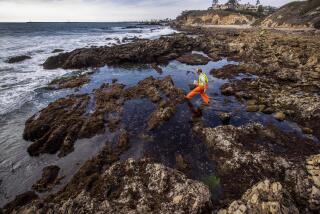Tanker Double Bottom Could Have Cut Exxon Spill by 60%, Study Says
- Share via
The nation’s worst oil spill could have been reduced substantially if the supertanker Exxon Valdez had been equipped with a double bottom when it ran aground March 24 in Alaska’s Prince William Sound, according to an internal Coast Guard study.
The study was criticized by an Exxon official on Wednesday as “witch hunt stuff.”
Based on computer-aided analyses by naval architects and engineers at the Coast Guard’s Marine Safety Center in Washington, the study found that as much as 60% of the 11-million gallon spill could have been saved.
“Clearly, double bottoms . . . are effective in reducing the potential oil outflow from grounding,” said the report, which is certain to fuel congressional debate over tanker safety rules.
The report stopped short of recommending any changes in federal ship design requirements, but Rep. George Miller (D-Martinez) said Wednesday he is considering legislation to make double bottoms mandatory. Such a requirement was actually promised by the Nixon Administration in the early 1970s when congressional approval of the controversial Alaskan pipeline was in doubt. The Coast Guard eventually decided not to impose the design on the Alaskan tanker fleet.
Design Criteria
Miller, chairman of the House Interior subcommittee which obtained the report, said the results suggest the public cannot count on promises of the oil industry to employ “safe tanker design criteria.”
In Houston, a spokesman for Exxon Shipping--longtime foe of laws requiring such a design--called the Coast Guard report premature since dry dock inspections of the Exxon Valdez have not even begun.
“Until the extent of actual structural damage can be assessed, these kinds of studies really aren’t conclusive,” said Exxon’s L. C. (Les) Rogers. “All this witch hunt stuff isn’t too meaningful. It’s all hypothetical.”
The Coast Guard based its analysis on a tanker modeled after the 1,100-foot Exxon Valdez--except that a double bottom 11.5-feet deep was installed. That space, running the length of the tanker, replaced two wing ballast tanks that would have been turned into cargo tanks for purposes of the study.
In its narrative, the Coast Guard report said the Exxon Valdez passed over a rock pinnacle that penetrated the hull near the bow and protruded 3 to 5 feet into the cargo tanks.
“This appears to have been a sharp pinnacle . . . which opened the ship like a knife,” the report said, noting that the pinnacle would not have reached 11.5 feet to the cargo tanks protected by the double bottom.
“The Exxon Valdez probably passed over this pinnacle in about one to two minutes, slowing from 12 knots to a stop,” the report continued. “The vessel then probably pivoted to starboard, going hard aground.”
‘Crushing Damage’
Even a double bottom would not have been able to prevent “crushing damage” to the ship’s starboard tanks after the pivot, according to the report.
But in a letter endorsing the report’s findings on May 30, Capt. John C. Maxham, chief of the Coast Guard’s marine technical and hazardous materials division, said the resulting spill most probably would have been reduced by 25% to 60%--possibly preventing about 6 million gallons of crude oil from pouring into the water.
Furthermore, Maxham noted, not only would the cargo tanks of a double-bottomed Exxon Valdez have suffered less damage from the rocks of Bligh Reef, but the leak rate would have been much slower, presumably giving cleanup crews more time to respond.
However, the Coast Guard official also noted that the same theoretical design would have been vulnerable to an even greater spill in a hypothetical collision between ships.
Exxon Studies
While opposed to mandatory double bottoms, Exxon does operate some tankers designed with that feature, Rogers said.
And last week, Exxon President William D. Stevens told Miller’s subcommittee that the oil company, too, had conducted computer-based case studies to determine how a double bottom might have affected the Exxon Valdez grounding. Stevens said “the likelihood was that the vessel would have capsized and gone to the bottom,” losing the entire cargo.
But an official at San Diego’s National Steel & Shipbuilding Co., which conducted the study for Exxon more than two months ago, said the Coast Guard had access to better data.
“We didn’t know anything about the ship’s speed or draft or the water depth,” acknowledged Al Lutter, senior vice president of the shipyard where the Exxon Valdez has been towed for repairs.
He said inspectors will get their first close-up look at the damage after Aug. 22 when the ship is scheduled to be lifted out of the water.
SAFETY IN DOUBLE HULLS The Coast Guard now theorizes that a double hull on the Exxon Valdez would have prevented Bligh Reef from penetrating the bow tanks on the huge tanker. As the ship rode over the reef, its weight would have crushed down upon the rocks, splitting some tanks, but the resulting oil spill would have been up to 60% smaller than the disaster last March.
Source: U.S. Coast Guard
More to Read
Sign up for Essential California
The most important California stories and recommendations in your inbox every morning.
You may occasionally receive promotional content from the Los Angeles Times.













